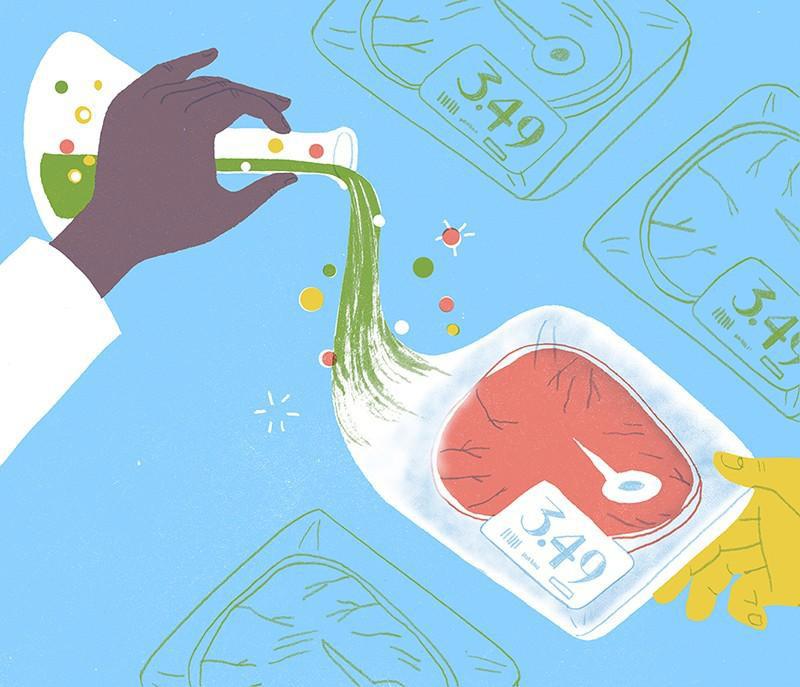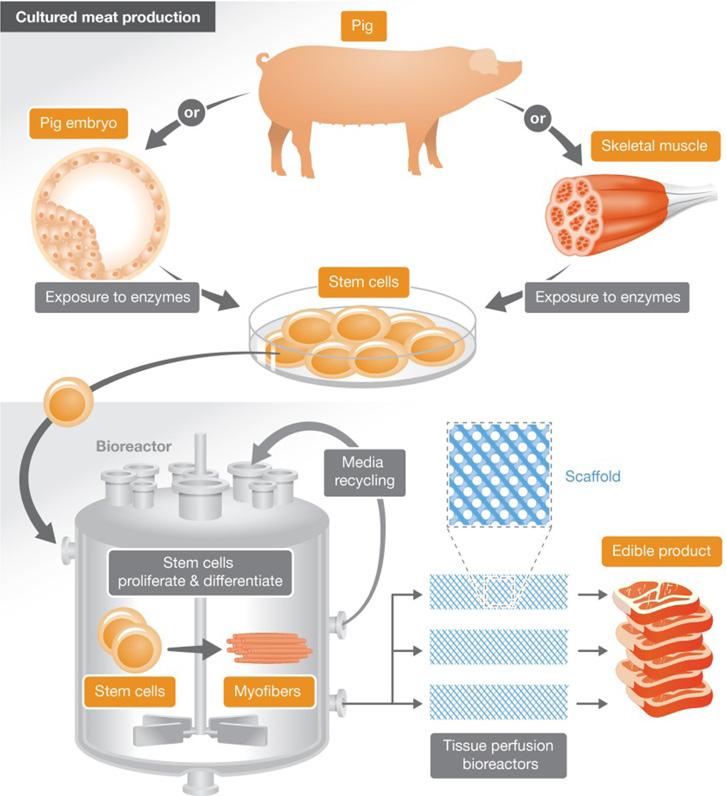
9 minute read
Cultured Meat: Growing Meat in the Lab Jane Li
from ORIGINS
CULTURED MEAT: GROWING MEAT IN THE LAB
BY JANE LI
Advertisement
Humans and meat consumption have an extensive evolutionary relationship. Homo sapiens are omnivores with natural preferences for both meat and plant consumption due to the history of hunting and eating meat that helped humans survive food scarcity. Nowadays, meat continues to play an important role in many cultures by contributing to a balanced diet due to its nutritional richness—meat consists of protein, vitamin B12, and more.1 However, meat needs to be farmed and processed before entering the market, and here, a problem arises: the conventional production process of meat negatively impacts the environment. This process requires large crop quantities for animal feed and a high proportion of agricultural land for raising animals—more than three-quarters of the world’s arable land.2 Expansion of animal agriculture has posed challenges to the environment due to the emission of massive amounts of greenhouse gases into the air, which was referred to as ‘Livestock’s long shadow’ by the Food and Agricultural Organization (FAO) in 2006. Indeed, recent statistics from the FAO show that total emissions from livestock account for 14.5 % of all anthropogenic greenhouse gas emissions.3 The conventional production process, focusing on production efficiency, fails to recognize other impacts such as climate change, animal welfare, or sustainability. To mitigate these adverse effects, scientists have developed a biotechnology that advocates for sustainable meat production. Implementing this biotechnology, which uses stem cell culturing techniques, could address the significant global threats of industrial livestock farming.4
THE COMPLEXITY OF MEAT
Cultured meat is also referred to as in-vitro meat, lab-grown meat, cell-based meat, and clean meat. Although the technology of producing cultured meat for human consumption is relatively new, the idea appeared in many science fiction stories during the nineteenth and twentieth century. In 1930, for instance, the idea was discussed by British statesman Frederick Edwin Smith who predicted: “It will no longer be necessary to go to the extravagant length

Figure 1. Derivation of Embryonic stem cells

Figure 2. Satellite cells (ASCs)
of rearing a bullock in order to eat its steak. From one ‘parent’ steak of choice tenderness it will be possible to grow as large and as juicy a steak as can be desired.” 5 However, the structural complexity of meat itself, consisting of diverse tissue types and intricate systems, is difficult to replicate outside of the body of animals. It is these unique qualities of meat that give it its distinct taste and texture—accordingly meat from mammals, poultry, and seafood differs based on muscle, fiber type, and thus quality and taste.6 Thus, replicating different types of meat in a laboratory requires a comprehensive understanding of meat’s structure and its components. It is due to this intricacy of meat that the idea of cultured meat did not receive significant attention in the scientific community until recent decades. In May 2005, the first comprehensive article elaborating on cultured meat was published in the journal Tissue Engineering. With continuing research around the world, scientists have gained a better understanding of meat structure and have found that necessary components of meat include skeletal muscle cells and adipocyte, or fat, tissues. Today, the possibility of growing meat in a lab is made possible by a very unique type of cell that could be used to culture muscle and fat tissues—stem cells.
STEM CELL TECHNOLOGY FOR CULTURED MEAT
Stem cells are unspecialized cells in the body that possess the ability to self-renew, differentiate, and develop a specialized functionality.7 The two main groups of stem cells, embryonic and adult stem cells, differentiate at the stage of derivation—when they are derived for culturing. Embryonic stem cells (ESC), derived during early development (blastocyst stage), can be cultured in laboratories and differentiated into any cell type in the body (pluripotent). In contrast, adult stem cells (ASC), found in adult tissues, are rarer and have a limited ability to differentiate into specialized tissues (multipotent or unipotent).8 Due to their ability to differentiate into different cell types, especially skeletal muscle and adipocyte tissues, stem cells from various development stages have been proposed as viable cells for meat culturing. Satellite cells, the adult stem cells associated with

Figure 3. Production process of cultured meat
Figure 4. Lab-grown burger created by Mark Post at Maastricht Univer-
sity. Credit: PA IMAGES/ALAMY STOCK PHOTO

skeletal muscle, which can easily differentiate into myotubes and myofibrils (skeletal muscle fibers), were identified by Mauro (1961) as functional in muscle regeneration after injury. Since these cells tend to mature and specialize as skeletal muscle fibers, they are considered to be ideal cells for skeletal muscle engineering.10 Besides ASCs and ESCs, induced pluripotent stem cells (iPSCs)—cells derived from reprogramming cells isolated from somatic tissue to a pluripotent state—are alternative, possible starting sources for cultured meat due to their pluripotency. In 2018, the first stable culture of bovine ESCs was reported to potentially differentiate into cell types necessary for skeletal muscle development.11 More excitingly, the culture could form a stable cell bank that prevents further biopsy—the removal of tissue—from animals. Mesenchymal stem cells (MSC), multipotent adult stem cells that are present in many tissues and which play vital roles in muscle development, could also serve as good starting cells.12 After cell selection, stem cells taken from muscle tissues or directly from embryos proliferate and differentiate into muscle cells, which are then transferred to a scaffold where they grow and develop into larger tissues. During this process, scientists need to provide the cells with an ideal growing environment known as cell culture medium. However, scientists face dilemmas in choosing an ideal culture medium.
CHALLENGES FACING CULTURED MEAT
Currently, cultured meat mainly uses animal-derived components such as fetal bovine serum (FBS) from dead calves, which is unsustainably sourced and contradicts the ethical principle of slaughter-free cultured meat. As a universal supplement containing hundreds of different proteins and thousands of small-molecule metabolites in unknown concentrations, it is both difficult as well as costly to replace FBS by a synthetic medium.4 Aiming for cell-specific media could be more cost-effective since FBS could be substituted by components such as hormones and growth factors that are specific to the cell line being grown.13 As soon as scientists can produce such media safely on an industrial scale, meat can be grown from a biopsy of an animal sample in the laboratory. But, scientists are still working to increase the efficiency and accuracy of cultured meat production. A more advanced tissue engineering approach, such as using textured soy protein as a scaffold to support cell attachment and proliferation, may be required to more accurately replicate meat.14 Today, efficiently producing meat safe for consumption in a lab is not yet possible, but it may be on the horizon.
A novel approach, meat in the laboratory has the potential to address animal welfare concerns and mitigate climate change through the use of stem cell technology. Stem cell research has gained much attention in the scientific community due to its great potential—applications of stem cell technology and tissue engineering are not limited to cultured meat and have already played vital roles in fields including medicine. Cultured meat research has made much progress in the past decade. In 2013, the world’s first biosynthesized burger was produced from bovine stem cells. Although it was produced at a high cost, the success was a hallmark in cultured meat research. Still, this area is in its infancy and requires more research that could address current challenges for it to potentially appear in our diets in the future decades.
1. Pereira, P. M. de C. C., & Vicente, A. F. dos R. B. (2013). Meat nutritional composition and nutritive role in the human diet.
Meat Science, 93(3), 586–592. https://doi.org/10.1016/j.meatsci.2012.09.018 2. Foley, J. A., Ramankutty, N., Brauman, K. A., Cassidy, E. S.,
Gerber, J. S., Johnston, M., Mueller, N. D., O’Connell, C., Ray,
D. K., West, P. C., Balzer, C., Bennett, E. M., Carpenter, S. R.,
Hill, J., Monfreda, C., Polasky, S., Rockström, J., Sheehan, J.,
Siebert, S., … Zaks, D. P. M. (2011). Solutions for a cultivated planet. Nature, 478(7369), 337–342. https://doi.org/10.1038/ nature10452 3. FAO - News Article: Key facts and findings. https://www.fao. org/news/story/en/item/197623/icode/ 4. Post, M. J., Levenberg, S., Kaplan, D. L., Genovese, N., Fu,
J., Bryant, C. J., Negowetti, N., Verzijden, K., & Moutsatsou,
P. (2020). Scientific, sustainability and regulatory challenges of cultured meat. Nature Food, 1(7), 403–415. https://doi. org/10.1038/s43016-020-0112-z 5. Treich, N. (2021). Cultured meat: Promises and challenges.
Environmental and Resource Economics, 79(1), 33–61. https:// doi.org/10.1007/s10640-021-00551-3 6. Zhang, X., Owens, C. M., & Schilling, M. W. (2017). Meat: The edible flesh from mammals only or does it include poultry, fish, and seafood? Animal Frontiers, 7(4), 12–18. https://doi. org/10.2527/af.2017.0437 7. Zakrzewski, W., Dobrzyński, M., Szymonowicz, M., & Rybak,
Z. (2019). Stem cells: Past, present, and future. Stem Cell Research & Therapy, 10, 68. https://doi.org/10.1186/s13287-0191165-5 8. Prochazkova, M., Chavez, M. G., Prochazka, J., Felfy, H.,
Mushegyan, V., & Klein, O. D. (2015). Embryonic versus adult stem cells. In A. Vishwakarma, P. Sharpe, S. Shi, & M.
Ramalingam (Eds.), Stem Cell Biology and Tissue Engineering in Dental Sciences (pp. 249–262). Academic Press. https://doi. org/10.1016/B978-0-12-397157-9.00020-5 9. Mauro, A. (1961). Satellite cell of skeletal muscle fibers. The
Journal of Biophysical and Biochemical Cytology, 9(2), 493–495. 10. Zhu, H., Park, S., Scheffler, J. M., Kuang, S., Grant, A. L., &
Gerrard, D. E. (2013). Porcine satellite cells are restricted to a phenotype resembling their muscle origin. Journal of Animal
Science, 91(10), 4684–4691. https://doi.org/10.2527/jas.20125804 11. Yuan, Y. (2018). Capturing bovine pluripotency. Proceedings of the National Academy of Sciences, 115(9), 1962–1963. https:// doi.org/10.1073/pnas.1800248115 12. Du, M., Yin, J., & Zhu, M. J. (2010). Cellular signaling pathways regulating the initial stage of adipogenesis and marbling of skeletal muscle. Meat Science, 86(1), 103–109. https://doi. org/10.1016/j.meatsci.2010.04.027 13. van der Valk, J., Brunner, D., De Smet, K., Fex Svenningsen,
A., Honegger, P., Knudsen, L. E., Lindl, T., Noraberg, J., Price,
A., Scarino, M. L., & Gstraunthaler, G. (2010). Optimization of chemically defined cell culture media—Replacing fetal bovine serum in mammalian in vitro methods. Toxicology in Vitro,
24(4), 1053–1063. https://doi.org/10.1016/j.tiv.2010.03.016 14. Ben-Arye, T., Shandalov, Y., Ben-Shaul, S., Landau, S., Zagury,
Y., Ianovici, I., Lavon, N., & Levenberg, S. (2020). Textured soy protein scaffolds enable the generation of three-dimensional bovine skeletal muscle tissue for cell-based meat. Nature Food, 1(4), 210–220. https://doi.org/10.1038/s43016-020-0046-5
IMAGE REFERENCES
15. Figure 1: Hynes, R. O. (2008). US policies on human embryonic stem cells. Nature Reviews Molecular Cell Biology, 9(12), 993–997. https://doi.org/10.1038/nrm2528 16. Figure 2: Muñoz-Cánoves, P., & Huch, M. (2018). Definitions for adult stem cells debated. Nature, 563(7731), 328–329. https://doi.org/10.1038/d41586-018-07175-6 17. Figure 3: Treich, N. (2021). Cultured Meat: Promises and Challenges. Environmental and Resource Economics, 79(1), 33–61. https://doi.org/10.1007/s10640-021-00551-3 18. Figure 4: Dolgin, E. (2020). Will cell-based meat ever be a dinner staple? Nature, 588(7837), S64–S67. https://doi. org/10.1038/d41586-020-03448-1 19. Cover image: Dolgin, E. (2020). Will cell-based meat ever be a dinner staple? Nature, 588(7837), S64–S67. https://doi. org/10.1038/d41586-020-03448-1










